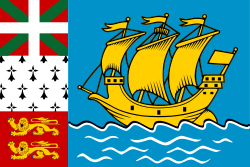 Unofficial flag of Saint Pierre and Miquelon | |
| Use | Unofficial flag |
|---|---|
| Proportion | 2:3 |
| Adopted | 1982 |
While the French overseas collectivity of Saint Pierre and Miquelon has no official flag and flies only the Flag of France, its parent nation, an unofficial flag was designed in 1982 and is often flown in the territory.



